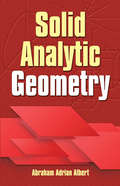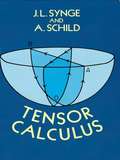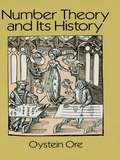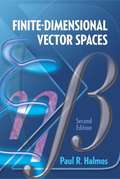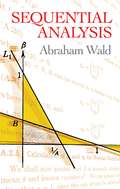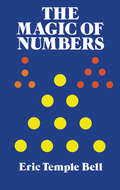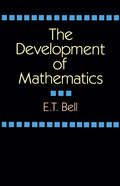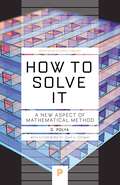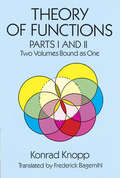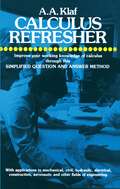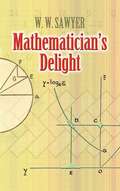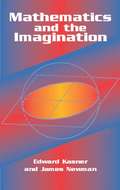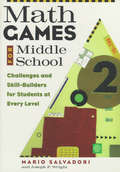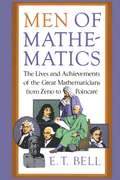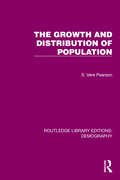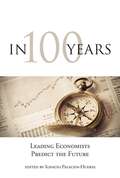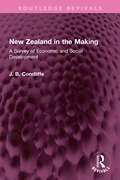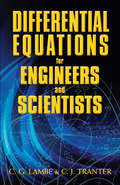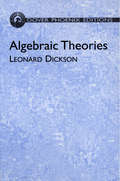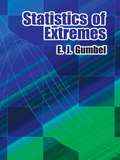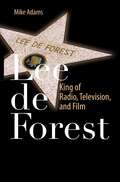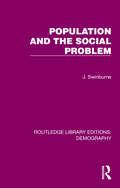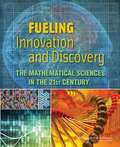- Table View
- List View
Solid Analytic Geometry (Dover Books on Mathematics)
by Abraham Adrian AlbertThe first seven chapters of this concise text provide an exposition of the basic topics of solid analytic geometry and comprise the material for a one-semester course on the subject for undergraduate mathematics majors. The remaining two chapters offer additional material for longer courses or supplementary study. Chapters 1 and 2 contain a treatment of the equations of lines and planes. Subsequent chapters offer an exposition of classical elementary surface and curve theory, a treatment of spheres, and an examination of the classical descriptions of quadric surfaces in standard position. An exploration of the theory of matrices follows, with applications to the three-dimensional case of quadric surfaces. The text concludes with a survey of spherical coordinates and elements of projective geometry.
Tensor Calculus
by J. L. Synge A. Schild"This book is an excellent classroom text, since it is clearly written, contains numerous problems and exercises, and at the end of each chapter has a summary of the significant results of the chapter." -- Quarterly of Applied Mathematics. Fundamental introduction for beginning student of absolute differential calculus and for those interested in applications of tensor calculus to mathematical physics and engineering. Topics include spaces and tensors; basic operations in Riemannian space, curvature of space, special types of space, relative tensors, ideas of volume, and more.
Number Theory and Its History
by Oystein OreUnusually clear, accessible introduction covers counting, properties of numbers, prime numbers, Aliquot parts, Diophantine problems, congruences, much more. Bibliography.
Finite-Dimensional Vector Spaces: Second Edition (Dover Books on Mathematics #7)
by Paul R. HalmosA fine example of a great mathematician's intellect and mathematical style, this classic on linear algebra is widely cited in the literature. The treatment is an ideal supplement to many traditional linear algebra texts and is accessible to undergraduates with some background in algebra. "This is a classic but still useful introduction to modern linear algebra. It is primarily about linear transformations … It's also extremely well-written and logical, with short and elegant proofs. … The exercises are very good, and are a mixture of proof questions and concrete examples. The book ends with a few applications to analysis … and a brief summary of what is needed to extend this theory to Hilbert spaces." — Allen Stenger, MAA Reviews, maa.org, May, 2016."The theory is systematically developed by the axiomatic method that has, since von Neumann, dominated the general approach to linear functional analysis and that achieves here a high degree of lucidity and clarity. The presentation is never awkward or dry, as it sometimes is in other 'modern' textbooks; it is as unconventional as one has come to expect from the author. The book contains about 350 well-placed and instructive problems, which cover a considerable part of the subject. All in all this is an excellent work, of equally high value for both student and teacher." — Zentralblatt für Mathematik.
Sequential Analysis (Phoenix Edition Ser.)
by Abraham WaldThe first to solve the general problem of sequential tests of statistical hypotheses, the author of this text explains his revolutionary theory of the sequential probability ratio test and its applications. 1947 edition.
The Magic of Numbers
by Eric Temple BellFrom one of the foremost interpreters for lay readers of the history and meaning of mathematics: a stimulating account of the origins of mathematical thought and the development of numerical theory. It probes the work of Pythagoras, Galileo, Berkeley, Einstein, and others, exploring how "number magic" has influenced religion, philosophy, science, and mathematics
Methods of Mathematical Physics
by Harold Jeffreys Bertha SwirlesThis well-known text and reference contains an account of those mathematical methods that have applications in at least two branches of physics. The authors give examples of the practical use of the methods taken from a wide range of physics, including dynamics, hydrodynamics, elasticity, electromagnetism, heat conduction, wave motion and quantum theory. They pay particular attention to the conditions under which theorems hold. Helpful exercises accompany each chapter.
The Development of Mathematics
by E. T. Bell"This important book . . . presents a broad account of the part played by mathematics in the evolution of civilization, describing clearly the main principles, methods, and theories of mathematics that have survived from about 4000 BC to 1940."- BooklistIn this time-honored study, one of the 20th century's foremost scholars and interpreters of the history and meaning of mathematics masterfully outlines the development of its leading ideas, and clearly explains the mathematics involved in each. According to the author, a professor of mathematics at the California Institute of Technology from 1926 until his death in 1960, it is "not a history of the traditional kind, but a narrative of the decisive epochs in the development of mathematics." It is a narrative filled with compelling insights of special interest to every mathematician, engineer, and scientist.Main trends in mathematics from approximately 4000 BC to the 20th century are presented through analyses of typical major episodes in each. The author first examines the evolution of mathematical ideas in the ancient civilizations of Egypt and Babylonia; later developments in India, Arabia, and Spain; and other achievements worldwide through the 16th century. Professor Bell then traces the beginnings of modern mathematics in the 17th century, and the emergence of the importance of extensions of number, mathematical structure, the generalization of arithmetic, and structural analysis. Compelling accounts of major breakthroughs in the 19th and 20th centuries follow, emphasizing rational arithmetic after Fermat, contributions from geometry, and topics as diverse as generalized variables, abstractions, differential equations, invariance, uncertainties, and probabilities. Throughout, Professor Bell subordinates details of mere antiquarian interest - involving concepts and ideas that did not succeed or bear fruit - in favor of the fullest possible exposition of those elements still alive in mathematics.
How to Solve It: A New Aspect of Mathematical Method (Princeton Science Library #34)
by G. PolyaThe bestselling book that has helped millions of readers solve any problemA must-have guide by eminent mathematician G. Polya, How to Solve It shows anyone in any field how to think straight. In lucid and appealing prose, Polya reveals how the mathematical method of demonstrating a proof or finding an unknown can help you attack any problem that can be reasoned out—from building a bridge to winning a game of anagrams. How to Solve It includes a heuristic dictionary with dozens of entries on how to make problems more manageable—from analogy and induction to the heuristic method of starting with a goal and working backward to something you already know.This disarmingly elementary book explains how to harness curiosity in the classroom, bring the inventive faculties of students into play, and experience the triumph of discovery. But it&’s not just for the classroom. Generations of readers from all walks of life have relished Polya&’s brilliantly deft instructions on stripping away irrelevancies and going straight to the heart of a problem.
Theory of Functions, Parts I and II (Dover Books on Mathematics)
by Konrad KnoppThis is a one-volume edition of Parts I and II of the classic five-volume set The Theory of Functions prepared by renowned mathematician Konrad Knopp. Concise, easy to follow, yet complete and rigorous, the work includes full demonstrations and detailed proofs.Part I stresses the general foundation of the theory of functions, providing the student with background for further books on a more advanced level.Part II places major emphasis on special functions and characteristic, important types of functions, selected from single-valued and multiple-valued classes.
Calculus Refresher (Dover Books on Mathematics)
by A. A. KlafThis book is unique in English as a refresher for engineers, technicians, and students who either wish to brush up their calculus or find parts of calculus unclear. It is not an ordinary textbook. It is, instead, an examination of the most important aspects of integral and differential calculus in terms of the 756 questions most likely to occur to the technical reader. It provides a very easily followed presentation and may also be used as either an introductory or supplementary textbook. The first part of this book covers simple differential calculus, with constants, variables, functions, increments, derivatives, differentiation, logarithms, curvature of curves, and similar topics. The second part covers fundamental ideas of integration (inspection, substitution, transformation, reduction) areas and volumes, mean value, successive and partial integration, double and triple integration. In all cases the author stresses practical aspects rather than theoretical, and builds upon such situations as might occur. A 50-page section illustrates the application of calculus to specific problems of civil and nautical engineering, electricity, stress and strain, elasticity, industrial engineering, and similar fields. 756 questions answered. 566 problems to measure your knowledge and improvement; answers. 36 pages of useful constants, formulae for ready reference. Index.
Mathematician's Delight
by W. W. Sawyer"Recommended with confidence" by The Times Literary Supplement, this lively survey starts with simple arithmetic and algebra and proceeds by gradual steps through graphs, logarithms, and trigonometry to calculus and the world of numbers. Generations of readers have found it the ideal introduction to mathematics, offering accessible explanations of how theory arises from real-life applications."The main object of this book is to dispel the fear of mathematics," declares author W. W. Sawyer, adding that "Many people regard mathematicians as a race apart, possessed of almost supernatural powers. While this is very flattering for successful mathematicians, it is very bad for those who, for one reason or another, are attempting to learn the subject." Now retired, Sawyer won international renown for his innovative teaching methods, which he used at colleges in England and Scotland as well as Africa, New Zealand, and North America. His insights into the pleasures and practicalities of mathematics will appeal to readers of all backgrounds.
Mathematics and the Imagination (Dover Books on Mathematics)
by James Newman Edward KasnerAnyone who gambles, plays cards, loves puzzles, or simply seeks an intellectual challenge will love this amusing and thought-provoking book. With wit and clarity, the authors deftly progress from simple arithmetic to calculus and non-Euclidean geometry. "Charming and exciting." -- Saturday Review of Literature. Includes 169 figures.
Math Games for Middle School: Challenges and Skill-Builders for Students at Every Level
by Mario Salvadori Joseph P. WrightFrom addition and subtraction to plane and space geometry, simultaneous linear equations, and probability, this book explains middle school math with problems that kids want to solve: "Seventy-five employees of a company buy a lotto ticket together and win $22.5 million. How much does each employee get?" Intriguing facts about the history of math show what a human creation it is, and human errors are revealed through explorations of both Maya and Hindu concepts of zero as well as Mr. William Shanks' 1858 attempt at hand-calculating pi.
Men of Mathematics
by E. T. BellHere is the classic, much-read introduction to the craft and history of mathematics by E.T. Bell, a leading figure in mathematics in America for half a century. Men of Mathematics accessibly explains the major mathematics, from the geometry of the Greeks through Newton's calculus and on to the laws of probability, symbolic logic, and the fourth dimension. In addition, the book goes beyond pure mathematics to present a series of engrossing biographies of the great mathematicians -- an extraordinary number of whom lived bizarre or unusual lives. Finally, Men of Mathematics is also a history of ideas, tracing the majestic development of mathematical thought from ancient times to the twentieth century. This enduring work's clear, often humorous way of dealing with complex ideas makes it an ideal book for the non-mathematician.
The Growth and Distribution of Population (Routledge Library Editions: Demography #10)
by S. Vere PearsonOriginally published in 1935, this book examines the causes of global rural depopulation, slum housing conditions and city over-crowding. The falling birth-rate in the West, town planning, ribbon development, emigration and traffic problems are also discussed with particular focus on how they affect the growth and distribution of populations. Social, psychological and economic factors are all considered, as well as those dependent on physical geography.
Lambda Calculus with Types
by Henk Barendregt Wil Dekkers Richard StatmanThe lambda calculus forms a prototype universal programming language, which in its untyped version is related to Lisp, and has been treated in the first author's classic The Lambda Calculus (1984). The formalism has since been extended with types and used in functional programming (Haskell, Clean) and proof assistants (Coq, Isabelle, HOL), which are used to design and verify IT products and mathematical proofs. In this book, the author focuses on three classes of typing for lambda terms: simple types, recursive types and intersection types. Unexpected mathematical beauty is revealed in these three formalisms of terms and types. Numerous exercises are provided to deepen the reader's understanding and increase their confidence using types.
In 100 Years
by Ignacio Palacios-HuertaThis pithy and engaging volume shows that economists may be better equipped to predict the future than science fiction writers. Economists' ideas, based on both theory and practice, reflect their knowledge of the laws of human interactions as well as years of experimentation and reflection. Although perhaps not as screenplay-ready as a work of fiction, these economists' predictions are ready for their close-ups. In this book, ten prominent economists -- including Nobel laureates and several likely laureates -- offer their ideas about the world of the twenty-second century. In scenarios that range from the optimistic to the guardedly gloomy, these thinkers consider such topics as the transformation of work and wages, the continuing increase in inequality, the economic rise of China and India, the endlessly repeating cycle of crisis and (projected) recovery, the benefits of technology, the economic consequences of political extremism, and the long-range effects of climate change. For example, Daron Acemoglu offers a thoughtful discussion of how trends of the last century -- including uneven growth, technological integration, and resource scarcity -- might translate into the next; 2013 Nobelist Robert Shiller provides an innovative view of future risk management methods using information technology; 2012 Nobelist Alvin Roth projects his theory of Matching Markets into the next century, focusing on schools, jobs, marriage and family, and medicine; 1987 Nobelist Robert Solow considers the shift away from remunerated labor, among other subjects; and Martin Weitzman raises the intriguing but alarming possibility of using geoengineering techniques to mitigate the nevitable effects of climate change. In a 1930 essay mentioned by several contributors, "Economic Possibilities for Our Grandchildren," John Maynard Keynes offered predictions that, read today, range from absolutely correct to spectacularly wrong. This book follows in Keynes's path, hoping, perhaps, to better his average.
New Zealand in the Making: A Survey of Economic and Social Development (Routledge Revivals)
by J. B. CondliffeFirst published in 1930, New Zealand in the Making is an economic history of the democratic experiments in New Zealand. The geography, population, government ownership of public utilities, compulsory arbitration, pensions and all other factors have been covered in detail. The book will be of interest to anyone keen on learning about New Zealand as well as to students of economy, history, agriculture, and government.
Differential Equations for Engineers and Scientists (Dover Books on Mathematics)
by C. G. Lambe C. J. TranterThis concise applications-oriented text is intended for undergraduate students in engineering, mathematics, and other areas of science. The first chapters focus on solutions of first order equations, linear equations with constant coefficients, and simultaneous equations and reducible equations. Subsequent chapters explore the method of solution by infinite series and the more important special functions of mathematical physics. The treatment examines the solution of partial differential equations as well as numerical methods of solution, including that of relaxation. Readers also receive an introduction to the theory of nonlinear differential equations. Nearly 900 worked examples and exercises include complete solutions, making this volume ideal for self-study as well as an excellent classroom text.
Algebraic Theories (Dover Books on Mathematics)
by Leonard DicksonThis in-depth introduction to classical topics in higher algebra provides rigorous, detailed proofs for its explorations of some of mathematics' most significant concepts, including matrices, invariants, and groups. Algebraic Theories studies all of the important theories; its extensive offerings range from the foundations of higher algebra and the Galois theory of algebraic equations to finite linear groups (including Klein's "icosahedron" and the theory of equations of the fifth degree) and algebraic invariants. The full treatment includes matrices, linear transformations, elementary divisors and invariant factors, and quadratic, bilinear, and Hermitian forms, both singly and in pairs. The results are classical, with due attention to issues of rationality. Elementary divisors and invariant factors receive simple, natural introductions in connection with the classical form and a rational, canonical form of linear transformations. All topics are developed with a remarkable lucidity and discussed in close connection with their most frequent mathematical applications.
Statistics of Extremes
by E. J. GumbelUniversally acknowledged as the classic text about statistics of extremes, this volume is geared toward use by statisticians and statistically minded scientists and engineers. It employs elementary terms to explain applications, favors graphical procedures over calculations, and presents simple generalizations as exercises -- all of which contribute to its value for students. Starting with definitions of its aims and tools, the text proceeds to discussions of order statistics and their exceedances, exact distribution of extremes, and analytical study of extremes. Additional topics include the first asymptotic distribution; uses of the first, second, and third asymptotes; and the range. 1958 edition. 44 tables. 97 graphs.
Lee de Forest
by Mike AdamsThe life-long inventor, Lee de Forest invented the three-element vacuum tube used between 1906 and 1916 as a detector, amplifier, and oscillator of radio waves. Beginning in 1918 he began to develop a light valve, a device for writing and reading sound using light patterns. While he received many patents for his process, he was initially ignored by the film industry. In order to promote and demonstrate his process he made several hundred sound short films, he rented space for their showing; he sold the tickets and did the publicity to gain audiences for his invention. Lee de Forest officially brought sound to film in 1919. Lee De Forest: King of Radio, Television, and Film is about both invention and early film making; de Forest as the scientist and producer, director, and writer of the content. This book tells the story of de Forest's contribution in changing the history of film through the incorporation of sound. The text includes primary source historical material, U.S. patents and richly-illustrated photos of Lee de Forest's experiments. Readers will greatly benefit from an understanding of the transition from silent to audio motion pictures, the impact this had on the scientific community and the popular culture, as well as the economics of the entertainment industry.
Population and the Social Problem (Routledge Library Editions: Demography #15)
by J. SwinburneOriginally published in 1924 and inevitably a product of the time in which it was published, the author assumes that people exercise their powers of reproduction near to capacity. The book views this pressure on population as a social problem, the fundamental cause of human and social challenges. Solutions such as a tax on children, public education and a laissez faire economic order are all suggested.
Fueling Innovation and Discovery
by Board on Mathematical Sciences And Their Applications National Research Council Committee on the Mathematical Sciences in 2025 Division on Engineering and Physical SciencesThe mathematical sciences are part of everyday life. Modern communication, transportation, science, engineering, technology, medicine, manufacturing, security, and finance all depend on the mathematical sciences. Fueling Innovation and Discovery describes recent advances in the mathematical sciences and advances enabled by mathematical sciences research. It is geared toward general readers who would like to know more about ongoing advances in the mathematical sciences and how these advances are changing our understanding of the world, creating new technologies, and transforming industries. Although the mathematical sciences are pervasive, they are often invoked without an explicit awareness of their presence. Prepared as part of the study on the Mathematical Sciences in 2025, a broad assessment of the current state of the mathematical sciences in the United States, Fueling Innovation and Discovery presents mathematical sciences advances in an engaging way. The report describes the contributions that mathematical sciences research has made to advance our understanding of the universe and the human genome. It also explores how the mathematical sciences are contributing to healthcare and national security, and the importance of mathematical knowledge and training to a range of industries, such as information technology and entertainment. Fueling Innovation and Discovery will be of use to policy makers, researchers, business leaders, students, and others interested in learning more about the deep connections between the mathematical sciences and every other aspect of the modern world. To function well in a technologically advanced society, every educated person should be familiar with multiple aspects of the mathematical sciences.
